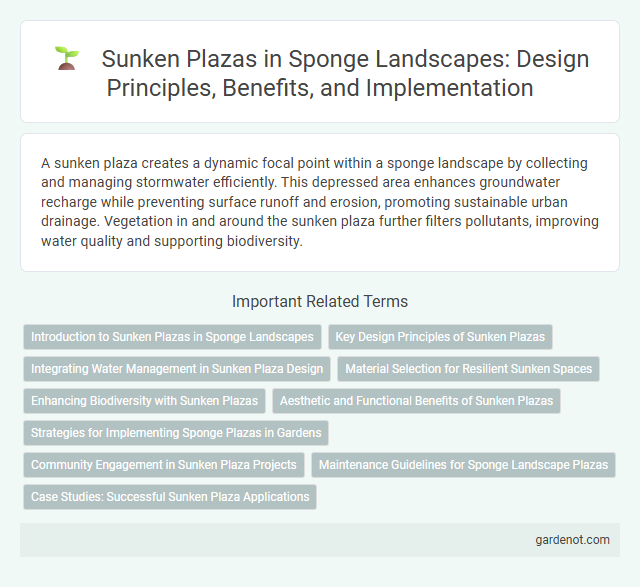A sunken plaza creates a dynamic focal point within a sponge landscape by collecting and managing stormwater efficiently. This depressed area enhances groundwater recharge while preventing surface runoff and erosion, promoting sustainable urban drainage. Vegetation in and around the sunken plaza further filters pollutants, improving water quality and supporting biodiversity.
Introduction to Sunken Plazas in Sponge Landscapes
Sunken plazas in sponge landscapes serve as strategically designed depressions that capture and absorb excess rainwater, reducing surface runoff and mitigating urban flooding. These plazas integrate permeable materials and vegetation to enhance water infiltration and promote groundwater recharge. Functioning as multifunctional urban spaces, they balance aesthetic appeal with effective stormwater management.
Key Design Principles of Sunken Plazas
Sunken plazas enhance urban spaces by creating intimate, multi-level areas that encourage social interaction while managing pedestrian flow efficiently. Key design principles include strategic use of durable materials for safety and aesthetics, integration of natural elements such as greenery and water features to promote environmental comfort, and incorporation of proper drainage systems to prevent water accumulation. Thoughtful lighting and clear sightlines improve security and accessibility, making sunken plazas functional and inviting public spaces.
Integrating Water Management in Sunken Plaza Design
Sunken plaza design prioritizes effective water management by incorporating permeable surfaces and strategic drainage systems to prevent flooding and promote groundwater recharge. Integrating rain gardens and bioswales within the sunken landscape enhances stormwater filtration and supports urban biodiversity. These water-smart solutions optimize water retention while maintaining the plaza's aesthetic and functional appeal.
Material Selection for Resilient Sunken Spaces
Choosing durable materials such as permeable concrete and weather-resistant pavers enhances water absorption and structural integrity in sunken plazas. Incorporating corrosion-resistant metals and treated timber ensures longevity against moisture exposure and fluctuating outdoor conditions. Strategic material selection supports resilient, low-maintenance sunken spaces optimized for effective stormwater management.
Enhancing Biodiversity with Sunken Plazas
Sunken plazas create unique microhabitats that support diverse plant and animal species by offering varied moisture levels and shelter conditions. These depressions capture rainwater and runoff, promoting native vegetation growth which attracts pollinators and contributes to urban biodiversity. Integrating sunken plazas in sponge landscapes enhances ecological resilience by increasing habitat complexity and supporting local ecosystems.
Aesthetic and Functional Benefits of Sunken Plazas
Sunken plazas enhance urban landscapes by creating visually striking multi-level spaces that promote natural light and ventilation, improving the aesthetic appeal of public areas. These recessed areas provide functional benefits like noise reduction from surrounding streets and natural drainage solutions, aiding stormwater management. Their design encourages social interaction and accessibility, transforming underutilized spaces into vibrant community hubs.
Strategies for Implementing Sponge Plazas in Gardens
Sunken plazas enhance rainwater management by capturing and filtering runoff directly within garden landscapes, reducing flood risks and promoting groundwater recharge. Incorporating permeable materials, strategic grading, and native vegetation maximizes the sponge plaza's absorption capacity and ecological benefits. Effective design also integrates overflow pathways to manage excess water during heavy storms, ensuring resilient and sustainable garden environments.
Community Engagement in Sunken Plaza Projects
Sunken plaza projects significantly enhance community engagement by creating accessible, multifunctional spaces that encourage social interaction and cultural activities. These plazas often incorporate seating arrangements, green landscaping, and interactive art installations that foster a sense of belonging and invite diverse groups to participate in communal events. Effective community-driven design processes ensure that sunken plazas reflect local identity and meet the social needs of residents, boosting urban vibrancy and inclusivity.
Maintenance Guidelines for Sponge Landscape Plazas
Regular inspection and debris removal are essential for maintaining the permeability and efficiency of sponge landscape sunken plazas. Implementing routine cleaning of filtration layers and drainage channels prevents clogging and ensures effective stormwater infiltration. Seasonal vegetation management and soil replenishment support the plaza's hydrological function and aesthetic appeal.
Case Studies: Successful Sunken Plaza Applications
Sunken plazas demonstrate effective urban design by enhancing public engagement and optimizing spatial usage in areas with limited ground-level space. Notable case studies like the Paley Park in New York City and the Rundle Mall in Adelaide showcase how sunken plazas create intimate social zones, improve pedestrian flow, and incorporate natural elements to mitigate urban heat. These applications highlight the potential of sunken plazas to foster vibrant community interactions while addressing environmental challenges in dense cityscapes.
Sunken plaza Infographic

 gardenot.com
gardenot.com